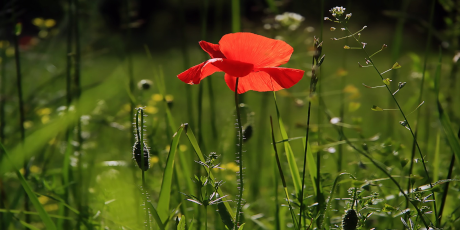How we've rediscovered the natural world during the lockdown 02 Jun 2020

From Dr Eoin Lettice, School of BEES and the ERI
Opinion: our reaction to the pandemic has changed how we view, value and utilise urban green spaces
The current pandemic and our reaction to it has led to the re-engineering of many elements of our society, including how we view, value and utilise urban green spaces. Throughout the lockdown, social media and news outlets have inundated us with stories and images of nature "returning" to our cities and towns, from a herd of goats in a Welsh town to dolphins swimming in the canals of Venice. Not all was as it seemed though. The dolphin video wasn’t filmed in Venice and the goats, while becoming somewhat braver with fewer humans around, are not unknown to visit the town of Llandudno "when it’s windy", according to one local resident.
We relished these images because they were shining beacons of light in the darkness. Their accuracy didn’t really matter. Many were willing to suspend disbelief in order to feel better about the situation they found themselves in.
Although reports of large, enigmatic animals re-invading our cities and towns may be wide of the mark, there is no doubt that one large animal species – Homo sapiens – has rediscovered its connection with the natural world around us.
It’s not just public green spaces, either. For those of us who are lucky enough to have them, there is a new-found obsession with our own private green spaces. Growing our own food and tending our gardens has rivalled the making of sourdough for remaining sane in these troubled times. Seed sales have soared. As Irish Minister for Health Simon Harris joked last week when announcing the easing of some restrictions, "never in our history has there been such a heightened sense of national excitement about the chance to go to a garden centre".
Despite restrictions on movement in many countries, parks have been busier than ever, probably exacerbated by the relatively mild spring and early summer that we’ve had, at least in Ireland. Although some of the usual amenities such as playgrounds are out-of-bounds, the very essence of the parks – open green spaces, trees and other plants - remain. In some cases, they’ve become so busy that certain "at-risk" groups have been given their own designated times to visit.
Hopefully, this pandemic is a game-change in how central and local governments view the importance of urban green spaces for building healthy, happy communities. Everybody should have access to such spaces within 2km of their homes. If this is not in place in the next few years, then we will have failed to learn from this pandemic.
The importance of nature in building healthy communities was clear even before the lockdown. Research has shown that exposure to nature for only 20 minutes can reduce stress. In a study that looked at the entire population of England, the death rate from cardiovascular disease in the most green areas was half that of the least green areas. Imagine the savings to the health budget.
The Japanese have long realised the benefits of Shinrin-Yoku or "Forest Bathing" for human physical and mental health. This is the practice of surrounding oneself with nature. It doesn’t mean exercising or hiking (although those things are great too). It just means connecting with nature through all our senses of sight, hearing, smell and touch. Like any alternative or complementary treatment, the practice suffers from proponents making exaggerated claims as to its efficacy, but there is good evidence of some health benefits such as reduced blood pressure.
There is no doubt that humans are drawn to natural settings. After all, just a tiny fraction of human existence has been spent living in urban environments. Humans, as a species, have spent over 99% of our time on earth living in nature.
The biologist E.O. Wilson coined the term "biophilia" and his hypothesis is that humans are hard-wired to connect with nature or as he put it, "an urge to affiliate with other forms of life". Humans in this lockdown have demanded the opportunity to do this. Citizens in Dublin have called for an end to through-traffic in the Phoenix Park and Cork locals have petitioned the city council to improve pedestrian access to the newly opened Tramore Valley Park. In the parks and green spaces themselves, new desire paths have quickly developed where people defy planners and make their own routes through the urban landscape, often encouraged by a need to social distance. Those designing our urban green spaces need to take note.
While it is more challenging to provide green spaces in certain areas of our cities, there should be an obligation to ensure that copious numbers of on-street trees are planted to help satisfy all urban-dwellers’ craving for the natural world. To not do so runs the risk of many citizens developing what has been described as "nature deficit disorder". Urban trees are known to provide numerous benefits which far outweigh the cost of planting and maintaining them. For example, such trees remove pollutants from the air, capture rainwater and reduce flooding, increase business, raise property prices and improve mental and physical health.
One thing that urban trees don’t do very well is sequester carbon. It’s not that they don’t do it, it’s that they don’t do it to the extent that makes this one of their major benefits. Work ongoing here in UCC shows that the urban trees planted in one whole parish in Cork city sequesters about the same amount of carbon as one Irish person’s carbon footprint. The argument for green spaces and trees in our cities will not be won on climate change alone, but there are many more benefits to urban green space and this lockdown has brought them to the fore.